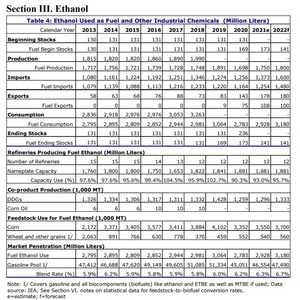Canada to import a record volume of US ethanol in 2022

August 29, 2022
BY Erin Krueger
Fuel ethanol consumption in Canada is expected to grow by approximately 8.6 percent this year, according to a report filed with the USDA Foreign Agricultural Service’s Global Agricultural Information Network. Imports of U.S. fuel ethanol are expected to reach a record 1.5 billion liters (396.26 million gallons).
According to the report, Canada is expected to consume approximately 3.18 billion liters of fuel ethanol this year, up from 2.928 billion liters in 2021, 2.783 billion liters in 2020 and 3.064 billion liters in 2019. Ethanol is expected to account for 6.7 percent of gasoline use in 2022, compared to 6.3 percent last year and 6.2 percent in 2020.
There are currently 12 ethanol plants located in Canada with a combined 1.881 billion liters of production capacity. The number of plants has held steady since 2018, with capacity maintained at its current level since 2020. Capacity use is expected to reach 95.7 percent this year, up from 93 percent in 2021 and 90.3 percent in 2020.
Advertisement
Canadian ethanol plants are expected to produce 1.8 billion liters of fuel ethanol this year, up from 1.75 billion liters in 2021 and 1.698 billion liters in 2020. Production, however, is expected to remain slightly below the 1.891 billion liters produced in 2019.
Corn is the primary feedstock used to produce fuel ethanol in Canada, with 3.7 million metric tons expected to be consumed this year, up from 3.55 million metric tons in 2021 and 3.352 million metric tons in 2020. An additional 560,000 metric tons of wheat and other grains is expected to go to fuel ethanol production this year, up from 540,000 metric tons in 2021 and 552,000 metric tons in 2020.
Canada is expected to export 180 million liters of ethanol this year, including 100 million liters of fuel ethanol. The country exported 178 million liters of ethanol last year, including 108 million liters of fuel ethanol, and 143 million liters in 2020, including 75 million liters of fuel ethanol.
Advertisement
Ethanol imports are expected to reach 1.6 billion liters this year, including 1.48 billion liters of fuel ethanol. Canada imported 1.373 billion liters of ethanol last year, including 1.254 billion liters of fuel ethanol, and 1.256 billion liters in 2020, including 1.164 billion liters of fuel ethanol.
Canadian imports of U.S. fuel ethanol reached a record 1.3 billion liters in 2021, up 8 percent when compared to 2020. Imports of U.S. fuel ethanol are expected to increase to 1.5 billion liters in 2022.
A full copy of the report is available on the USDA FAS GAIN website.
Related Stories
The U.S. Energy Information Administration maintained its forecast for 2025 and 2026 biodiesel, renewable diesel and sustainable aviation fuel (SAF) production in its latest Short-Term Energy Outlook, released July 8.
XCF Global Inc. on July 10 shared its strategic plan to invest close to $1 billion in developing a network of SAF production facilities, expanding its U.S. footprint, and advancing its international growth strategy.
U.S. fuel ethanol capacity fell slightly in April, while biodiesel and renewable diesel capacity held steady, according to data released by the U.S. EIA on June 30. Feedstock consumption was down when compared to the previous month.
XCF Global Inc. on July 8 provided a production update on its flagship New Rise Reno facility, underscoring that the plant has successfully produced SAF, renewable diesel, and renewable naphtha during its initial ramp-up.
The U.S. EPA on July 8 hosted virtual public hearing to gather input on the agency’s recently released proposed rule to set 2026 and 2027 RFS RVOs. Members of the biofuel industry were among those to offer testimony during the event.
Upcoming Events










